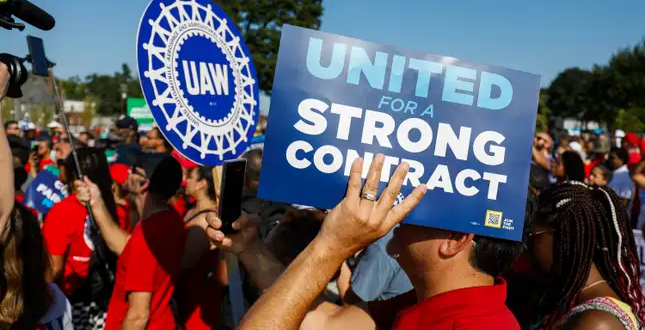The United Auto Workers (UAW) is a pivotal entity within the fabric of American labor history, marking its inception in the tumultuous 1930s. Born out of the dire need for workers’ rights amidst the industrial boom, the UAW rapidly became a cornerstone for labor advocacy, particularly within the automotive sector. Its formation was not merely an act of unionization but a revolutionary movement that sought to redefine the dynamics between labor and capital. The UAW’s early years were characterized by fervent struggles, including sit-down strikes and mass mobilizations, which not only underscored the workers’ grievances but also demonstrated their unwavering resolve. These initial confrontations laid the groundwork for the UAW’s legacy, establishing it as a formidable force in negotiating workers’ rights, wages, and working conditions.
The Golden Era of UAW
The post-World War II era heralded what many consider the golden age for the UAW, a period when the union’s influence and membership reached unprecedented heights. This era was marked by significant economic growth and industrial expansion, particularly within the automotive industry, which served as the backbone of American manufacturing. The UAW, under visionary leadership, capitalized on this momentum to secure landmark agreements that significantly improved workers’ lives. These agreements included not only better wages but also pioneering benefits such as health insurance, pension plans, and job security measures. The UAW’s success during this period was not just in its ability to negotiate favorable terms but also in setting a benchmark for labor rights that transcended the auto industry, influencing labor practices across various sectors.
Challenges and Adaptations
However, the landscape began to shift as globalization and technological advancements took center stage towards the end of the 20th century. The UAW found itself grappling with an array of challenges, from the outsourcing of jobs to foreign competition and the advent of automation. These changes threatened the very core of the UAW’s membership base, leading to a decline in union density and bargaining power. In response, the UAW embarked on a path of adaptation and resilience. It expanded its representation beyond the traditional automotive sector to include workers from diverse fields such as academia, healthcare, and government sectors. This strategic diversification not only broadened the UAW’s influence but also injected new vitality into its ranks, showcasing the union’s ability to evolve in the face of changing industrial landscapes.
The UAW in the 21st Century
The dawn of the 21st century brought with it a new set of challenges and opportunities for the UAW. The financial crises of the early 2000s, coupled with the automotive industry’s downturn, put immense pressure on the union to defend its members’ interests. The UAW played a critical role during the automotive bailout negotiations, advocating for worker protections amidst corporate restructuring. This period underscored the UAW’s enduring commitment to its core principles of worker solidarity and social justice, even in the face of adversity. Moreover, the recent years have seen the UAW increasingly engage in social and political causes, from advocating for environmental sustainability to championing workers’ rights on a global scale. This expansion of focus reflects the UAW’s recognition of the interconnectedness of labor rights with broader societal issues.
The Road Ahead
As the UAW looks towards the future, it faces a complex landscape shaped by rapid technological changes, shifting economic policies, and an increasingly globalized workforce. The rise of electric vehicles, automation, and digital platforms presents both challenges and opportunities for the UAW. Adapting to these changes requires not just negotiating new terms of employment but also redefining the very nature of work and workers’ rights in the digital age. The UAW’s ability to navigate these changes will be crucial in sustaining its relevance and effectiveness as a champion of labor rights.
Moreover, the UAW continues to confront internal challenges, including maintaining member engagement and addressing issues of governance and transparency. The path forward necessitates a renewed commitment to democratic principles within the union, ensuring that the UAW remains responsive to its members’ needs and aspirations.
Conclusion
The UAW’s journey from its inception to its current standing is a testament to the enduring power of collective action in advocating for workers’ rights. Its historical achievements have not only improved the lives of its members but also set precedents that benefit workers across various sectors. As the UAW navigates the complexities of the 21st century, its legacy serves as both a foundation and a beacon, guiding its continued efforts to champion the dignity of labor in an ever-evolving economic landscape. The UAW’s story is far from over; it is an ongoing narrative of resilience, adaptation, and unwavering commitment to the principles of justice and equity in the workplace.
UAW FAQs
Who can join the UAW?
Membership is open to workers in sectors represented by the UAW, which includes automotive, aerospace, agricultural implement manufacturing, higher education, healthcare, and other industries. Both active workers and retirees can be members.
What are some key achievements of the UAW?
The UAW has secured numerous achievements for its members, including significant wage increases, health and safety standards, job security measures, comprehensive healthcare benefits, and retirement plans. It has also been instrumental in advocating for social justice issues and labor rights on a broader scale.
How does the UAW negotiate contracts?
The UAW negotiates contracts through a process known as collective bargaining, where union representatives and employers discuss and agree on the terms of employment, including wages, working hours, benefits, and other work-related conditions. These negotiations often occur every few years when the current contract expires.
 Inspirescroll
Inspirescroll
